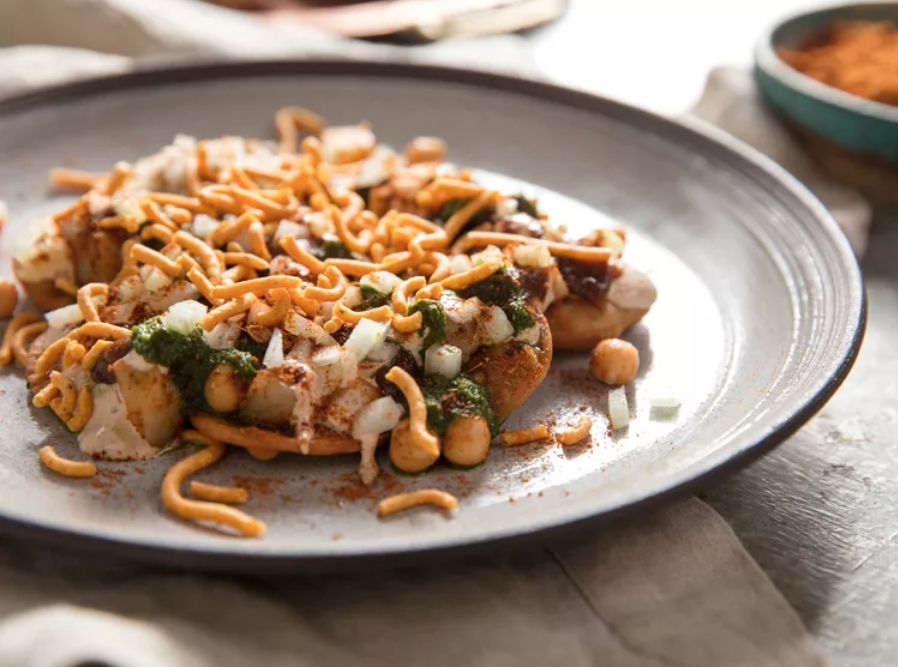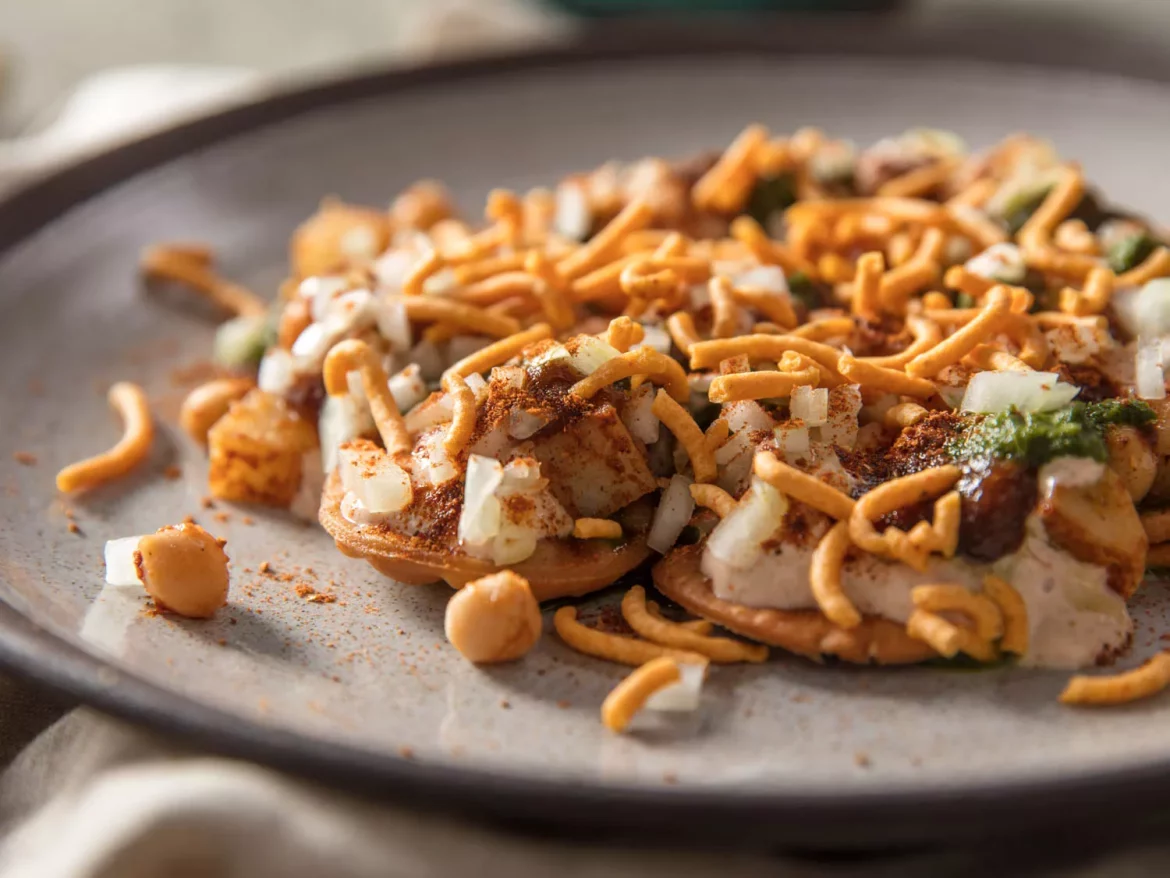Papri Chaat is an iconic Indian street snack that tantalizes the taste buds with its delightful combination of crispy, spicy, tangy, and sweet flavors. Originating from the bustling streets of India, Papri Chaat is a beloved part of Indian culinary culture, celebrated for its vibrant flavors and diverse textures. This comprehensive guide explores the origins, preparation, variations, and cultural significance of Papri Chaat, offering an in-depth understanding of this delectable dish.
1. The History and Origins of Papri Chaat
Historical Context
Papri Chaat, also known simply as “Chaat,” has a rich history rooted in Indian street food culture. The term “chaat” refers to a variety of savory snacks that are typically served at roadside stalls or street vendors. These snacks are known for their bold flavors and diverse ingredients. Papri Chaat is one of the most popular varieties, particularly in North India.
The origins of Chaat can be traced back to the ancient Indian practice of combining various ingredients to create a medley of flavors. Chaat evolved over time, incorporating different regional influences and ingredients. The specific variant known as Papri Chaat features crispy dough wafers called “papri,” which are topped with a variety of savory and sweet components.
Cultural Significance
Papri Chaat holds a special place in Indian cuisine, symbolizing the vibrant and diverse street food culture of India. It is commonly enjoyed as a snack or appetizer and is a staple at social gatherings and festive occasions. The dish represents the ingenuity of Indian street food vendors who creatively combine ingredients to produce flavorful and satisfying snacks.
2. Ingredients for Papri Chaat
Papri Chaat is a multi-layered dish that requires several components to achieve its distinctive taste and texture. Here are the essential ingredients and their roles in the dish:

Core Ingredients
For the Papri (Crispy Wafers):
- 1 cup all-purpose flour: Forms the base of the papri dough.
- 1/4 cup semolina (rava): Adds crispiness to the papri.
- 1/4 teaspoon caraway seeds (ajwain): Provides a unique flavor.
- 1/2 teaspoon cumin seeds: Adds depth to the papri.
- 1/4 teaspoon baking powder: Helps the papri puff up.
- 1/4 teaspoon salt: For seasoning.
- 2 tablespoons ghee or oil: For richness and to help bind the dough.
- Water: As needed, to form a smooth dough.
- Oil: For deep-frying the papri.
For the Toppings:
- 1 cup boiled and chopped potatoes: Adds a hearty element.
- 1 cup boiled chickpeas: Provides protein and texture.
- 1/2 cup yogurt: Adds creaminess and tang.
- 1/2 cup tamarind chutney: For a sweet and tangy flavor.
- 1/2 cup coriander-mint chutney: Provides freshness and spice.
- 1/4 cup finely chopped onions: Adds crunch and sharpness.
- 1/4 cup finely chopped tomatoes: For freshness and color.
- 1/4 cup chopped cilantro (coriander leaves): For garnish.
- 1 teaspoon roasted cumin powder: Adds warmth and depth.
- 1 teaspoon chaat masala: A spice blend that gives the dish its characteristic flavor.
- Salt and black pepper: To taste.
Optional Ingredients
- Pomegranate seeds: For a burst of sweetness and color.
- Sev (crispy chickpea noodles): For additional crunch.
- Green chilies: For extra heat.

3. Preparation and Cooking Instructions
Step-by-Step Guide
3.1. Preparing the Papri
- Making the Dough: In a mixing bowl, combine the all-purpose flour, semolina, caraway seeds, cumin seeds, baking powder, and salt. Add the ghee or oil and mix until the mixture resembles coarse crumbs. Gradually add water and knead into a smooth, firm dough.
- Rolling and Cutting: Divide the dough into small portions and roll each portion into a thin circle or oval shape. Use a rolling pin to ensure an even thickness. Cut the rolled dough into small rounds or squares using a cookie cutter or knife.
- Frying: Heat oil in a deep frying pan or wok over medium heat. Fry the papri in batches until they turn golden brown and crisp. Remove with a slotted spoon and drain on paper towels to remove excess oil.
3.2. Assembling the Chaat
- Layering the Base: Arrange the fried papri on a serving platter or individual plates. The papri serves as the base for the chaat and should be evenly distributed.
- Adding the Toppings: Layer the boiled potatoes and chickpeas over the papri. Spoon the yogurt over the top, followed by the tamarind chutney and coriander-mint chutney.
- Adding Fresh Ingredients: Sprinkle finely chopped onions, tomatoes, and cilantro over the layered ingredients.
- Seasoning: Sprinkle roasted cumin powder and chaat masala over the top. Add salt and black pepper to taste.
- Finishing Touches: Garnish with pomegranate seeds, sev, and additional cilantro if desired.
3.3. Serving
- Serving Immediately: Serve Papri Chaat immediately after assembling to ensure the papri remains crisp.
- Accompaniments: This dish pairs well with additional chutneys or yogurt on the side for extra flavor.
4. Variations and Tips
Creating Variations
4.1. Different Toppings
- Vegetable Variations: Add other vegetables like diced cucumber or shredded carrots for added crunch and freshness.
- Protein Options: Substitute chickpeas with black beans or lentils for a different protein source.
4.2. Flavored Papri
- Herbed Papri: Add chopped herbs like cilantro or mint to the dough for a herbal twist.
- Spicy Papri: Incorporate chili powder or paprika into the dough for a spicy kick.
4.3. Healthy Alternatives
- Baked Papri: For a healthier option, bake the papri instead of frying them. Brush with a little oil and bake at 350°F (175°C) until crisp.
- Greek Yogurt: Use Greek yogurt instead of regular yogurt for a lower-fat option.

Tips for Perfecting the Dish
- Crispy Papri: Ensure the oil is hot enough before frying the papri to achieve a crispy texture. If the oil is too cool, the papri will absorb excess oil and become soggy.
- Assembling Just Before Serving: Assemble the chaat just before serving to keep the papri crispy. If prepared too early, the papri may become soft due to the moisture from the toppings.
- Adjusting Spice Levels: Customize the spice levels according to your preference by adjusting the amount of chaat masala, chili powder, or green chilies.
5. Cultural Significance and Modern Interpretations
Street Food Culture in India
Papri Chaat is a quintessential example of India’s vibrant street food culture. Street food in India is characterized by its diversity, bold flavors, and accessibility. Vendors across the country serve a variety of chaats, each with its own regional twist. Papri Chaat, with its combination of crispy wafers and flavorful toppings, is a staple of Indian street food and a favorite among locals and visitors alike.
Modern Adaptations
In recent years, Papri Chaat has gained popularity beyond Indian street food stalls and is now featured in restaurants and home kitchens worldwide. Chefs and home cooks have embraced the dish’s versatility, experimenting with new ingredients and techniques to create innovative versions of Papri Chaat. Modern adaptations often include gourmet ingredients, fusion flavors, and creative presentations.
Celebrating Indian Cuisine
Preparing and enjoying Papri Chaat is a celebration of Indian culinary traditions and street food culture. The dish embodies the essence of Indian cuisine with its vibrant flavors, diverse textures, and communal eating experience. By exploring Papri Chaat, we gain insight into the richness and diversity of Indian food and its significance in cultural and social contexts.
6. Pairing and Serving Suggestions
Beverage Pairing
Papri Chaat pairs well with a variety of beverages. Consider serving it with traditional Indian drinks such as Masala Chai (spiced tea) or Lassi (yogurt-based drink) for a complete Indian dining experience. For a non-alcoholic option, chilled lemonade or mint iced tea can also complement the flavors of the chaat.
Side Dishes
Serve Papri Chaat as an appetizer or snack alongside other Indian dishes. It pairs well with Samosas (savory pastries filled with spiced potatoes or meat), Pakoras (deep-fried fritters), or Pani Puri (crisp puris filled with spicy water and tamarind chutney) for a diverse and satisfying meal.
Conclusion
Papri Chaat is a delightful and iconic Indian street snack that offers a harmonious blend of crispy, tangy, spicy, and sweet flavors. Its rich history, diverse ingredients, and cultural significance make it a cherished part of Indian cuisine. By understanding the

